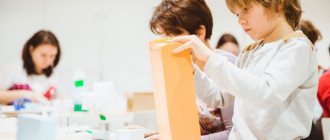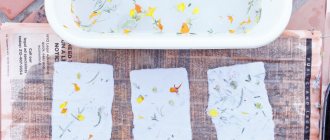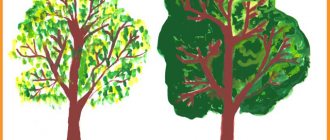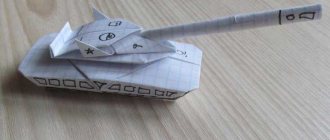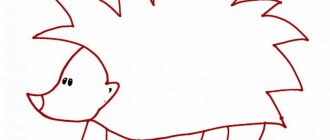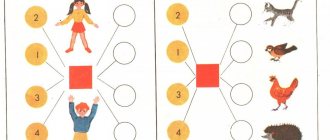Making a Floral Card
Before starting work, you should prepare a sheet of thick cardboard, colored paper, glue and scissors. Next you need to follow the step-by-step instructions:
- Choose a template for any flower you like: tulip, original rose, lush peony.
- Using the template, outline the main details: bud, leaves and stem.
- Fold a sheet of cardboard in half to make a simple postcard model.
- Paint the outside of the card with watercolors and let the paint dry.
- Glue the flower details onto the title page.
If the child wishes, you can decorate the card with additional icons or symbols, beads or rhinestones. Parents can help make a congratulatory inscription.
Cotton pads
This material is popular in works with winter and New Year themes. Fluffy snow-white “rounds” seem to be asking to be used in an applique with a snowman! They easily become dense snowdrifts and light snowflakes, but can also be a sheep's coat.
Painted discs can be used in narrative pictures and panels in almost the same way as colored paper. But these works will be distinguished by volume, special warmth and softness.
Safety precautions at work
When working together with your child to create a craft, you should follow certain safety precautions:
- Avoid contact with parts that are too small.
- Work with scissors and glue only under the supervision of an adult.
- Do not allow paint, glue or other liquid components to get into the child’s eyes.
We recommend reading:
Crafts from plasticine: the best master class for children at school or kindergarten. 90 photos of the best ideas for creating plasticine figuresFelt crafts - the best patterns and templates. Step-by-step instructions and master class for beginners (130 photo ideas)
DIY crafts from egg trays - the best step-by-step master class, with description. TOP 100 photos of original ideas for crafts
If these simple conditions are met, the work will bring only joy and unforgettable impressions to the child.
Cereal applique
Materials you may need:
- Glue.
- Thick cardboard.
- A finished picture or photograph from which the master will work.
A wide variety of cereals are used: millet, rice, pearl barley. A circle is drawn on the cardboard, indicating the boundaries of the application. Next, coat the base areas with glue, and place the cereal of your choice on the surface.
Different details of the design are decorated with different grains. If desired, the glued cereals can be painted with ordinary watercolors.
Available materials
Acquaintance with this type of creativity usually also occurs in kindergarten. The materials used are cardboard and plastic plates, disposable cups, spoons and forks, colored bottle caps, buttons and much more.
Starting with simple crafts, children gradually move on to more complex models that require diligence, good coordination and constructive thinking. Ordinary objects used in everyday life or out of use, which have become crafts, for children - a miracle created with their own hands, a little magic!
Master classes on making crafts
There are a lot of options and ideas for children's compositions; the choice depends on the given topic, the personal wishes of the child and parents.
We recommend reading:
DIY crafts from Kinder surprise eggs - 125 photos of exclusive options with step-by-step instructions, master class and videoCrafts made from twine - an overview of original design solutions. More than 100 photos of new products + step-by-step instructions for creating crafts with your own hands
DIY crafts from candy wrappers: 150 photos of the best ideas from craftswomen. Simple instructions, master class, diagrams and video tutorials on creating crafts from candy wrappers
In some cases, these can be either single figures of animals or characters, or real compositions and pictures.
Natural materials
You can learn to love and appreciate nature not only by observing its natural beauty, but also by using its fruits in applied creativity. This type of activity develops associative thinking and, perhaps more than other educational activities, is similar to a game.
Hand-made figures made from cones, acorns, seeds, twigs and shells awaken children's imagination and stimulate cognitive interest. A variety of techniques for working with natural materials allows you to choose the one that best suits your age, training and design.
Themed crafts for children 5 years old will help them get acquainted with the surrounding world of their native land, study the seasonal characteristics of plants, the habits of animals, and make an original and beautiful gift.
A plasticine oval with a pointed nose, studded with cones, ash parachute seeds, sunflower seeds, spruce needles or acorns, turns into a hedgehog; with a long, gracefully curved neck, complemented on the sides with a pair of leaves or large shells - like a swan; a flattened ball with an elongated head, decorated with walnut shells - like a turtle.
A tin coffee can tightly covered with plasticine, decorated with an ornament of seeds, will become a cute vase, and a tea box, covered with peas, leaves or crushed eggshells, will become a box for needlework.
Not to mention the numerous options for making people from cones and acorns, genre scenes from vegetables and fruits, panels from dried flowers and leaves.
Working with natural materials, like any creative activity, is an excellent option for interesting and rich children’s leisure time and an opportunity to create something beautiful and useful that can please friends and family. And this is also very important for children!
Application for March 8
An original craft will be an applique in the shape of a big heart. To make it you will need:
- Colored cardboard.
- Scissors.
- Glue.
- Thread and needle.
First of all, the heart itself is made: a blank is cut out of colored cardboard according to the template. The edges of the future applique are stitched with thick thread to create a relief pattern.
From voluminous woolen threads, a rose or chamomile stem is laid out on glue on top of a cardboard base (at the request of the master). The bud can also be made from a ball of snow-white yarn.
Types of crafts for kindergarten
All crafts are divided into groups depending on the shape, manufacturing technique, materials used and decor.
